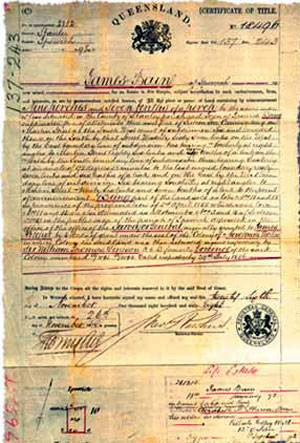Freehold land administration
First dealings with freehold land
The first dealings with freehold land were made under the Registration of Deeds Act 1843. This act was administered by the Registrar-General of New South Wales.
Queensland became a state in its own right in 1859 by separating from New South Wales. The Crown on behalf of the state of Queensland owned all the land in the state except that which had previously been granted to individuals. Soon after separation, copies of all deeds and conveyances were forwarded to Queensland. From that time, registration was effected by the Registrar General of Queensland.

Torrens Title system
The Torrens Title system was implemented in Queensland with the proclamation of the Real Property Act 1861. Freehold land granted by the Crown prior to that time was dealt with under the 'Old System' of titling under the Registration of Deeds Act 1843. Unlike other states, all identified 'Old System land' in Queensland has now been converted to Torrens Title.
The Torrens System ensures that a person purchasing land is able to acquire a secure title to that land in a process that facilitates timely and effective land dealings for the community. The Torrens System, through the provisions of the Land Title Act 1994 in Queensland, ensures that the interests of registered owners, and other registered proprietors, of land are protected.
The State guarantees title to freehold land upon registration of certain instruments. However, it is important to note that the system is 'title by registration', and not 'registration of title'. Therefore, a person must have their interest in land registered in order to have recognised legal title and to benefit from the security and other protections inherent in Torrens Title.
In contrast to the old paper-based titling system, the Land Title Act 1994 did not provide for the automatic issue of a duplicate title (referred to as a certificate of title) and the registered owner had to apply to have a certificate of title issued.
Certificates of title were discontinued on 1 October 2019 and no longer have any legal effect.
Prosperous land sales lead to new registries
There was a boom in land exchange and land acquisition between the late 1870s and early 1880s, which led to a significant rise in government revenue. The number of transactions rose from 6,035 in 1878 to 12,033 in 1883 and likewise revenue from £5,499 to £8,690. As a result of this boom all duties carried out by the Registrar-General relating to registration of deeds were transferred to and vested in the newly formed Registrar of Titles under the Registrar of Titles Bill of 1884.
Around 1887, when it seemed that plans were underway to establish separate colonies in central and northern Queensland, the debate of creating district registries in these regions arose. One participating unidentified gentleman quipped:
‘When we get complete separation, as we no doubt shall within two or three years, this will be included, and this Bill is simply an anticipation of it; and ... it may save us the expense of a new system ...’
The district registries were opened in Rockhampton and Townsville in 1888, but no further colony separations eventuated. The lodgement of plans for registration was then able to be executed outside Brisbane. Today, the central registry is located in Brisbane with a network of titling lodgement offices throughout the state.
Another significant change occurred around 1935 with maps showing real property information including boundary and tenure details being produced for the first time. These maps were known as parish maps or working maps and provided useful information to the public.
Computerised collection and delivery
On 24 April 1994, the Land Title Act 1994 was proclaimed. This act provided for the implementation of a computerised register—the Automated Titles System (ATS)—to replace the former paper-based Titles Register.
At that time, the project of converting all current title information (from 2.6 million paper titles) to computer data in ATS was completed in just 18 months.
ATS not only creates legal electronic registers, but through computerisation, automates the registration process. This provides significant benefits for the community and the real property industry (e.g. ready access to current and accurate title information online in real-time).
The Titles Registry (formerly known also as the Titles Office and Land Registry) is currently working to convert copies of around 4,800,000 old titling instruments stored on microfilm to computer images in ATS.


